
Augustus Radcliffe Grote was a British entomologist who described over 1,000 species of butterflies and moths. He is best known for his work on North American Noctuidae. A number of species were named after him, including the moth Horama grotei.

Sitochroa is a genus of moths of the family Crambidae.

Chytolita is a monotypic litter moth genus of the family Erebidae erected by Augustus Radcliffe Grote in 1873. Its only species, Chytolita morbidalis, the morbid owlet moth or morbid owlet, was first described by Achille Guenée in 1854. It is found in large parts of North America, from coast to coast in the north and south to North Carolina, Texas and Florida in the west. The habitat consists of deciduous woods and edges.

Euxoa is a genus of moths of the family Noctuidae raised to Genus by the German entomologist, Jacob Hübner. The Genus is mostly confined to dry and semi dry areas in the Northern Hemisphere. There 130 species in Eurasia, a few in Africa, and 175 in North America. There are no species in the Genus in South-East Asia or in Australia. In North America, most species are found in Western regions. Of the North American species, 4 are endemic to Mexico. There is one species recorded from Chile, but this may be a mislabeled specimen. In real terms, species numbers do not equal species abundance. Some areas with few species have large numbers of the ones that do live there.
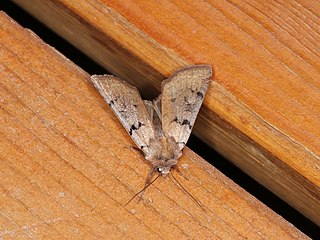
Richia is a genus of moths of the family Noctuidae.
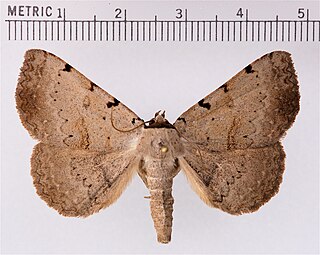
Spiloloma is a monotypic moth genus in the family Erebidae. Its only species, Spiloloma lunilinea, the moon-lined moth, is found in eastern and south-central North America. Both the genus and species were first described by Augustus Radcliffe Grote in 1873.

Mellilla is a monotypic moth genus in the family Geometridae erected by Augustus Radcliffe Grote in 1873. Its only species, Mellilla xanthometata, the orangewing moth, was first described by Francis Walker in 1862. It is found in most of eastern North America.

Acronicta sperata, the hopeful dagger moth, is a moth of the family Noctuidae. The species was first described by Augustus Radcliffe Grote in 1873. It is found in North America from New Brunswick west to the Alberta foothills, south to the District of Columbia, Missouri and in the mountains to Colorado.

Catocala meskei, or Meske's underwing, is a moth of the family Erebidae. The species was first described by Augustus Radcliffe Grote in 1873. It is found in North America from Maine and Quebec west to southern Alberta and Montana, south to South Carolina in the east and at least Montana in the west.

Sympistis glennyi is a moth of the family Noctuidae first described by Augustus Radcliffe Grote in 1873. It is found in western North America from the mountains of southern Alberta west to British Columbia and south at least to Colorado and California.
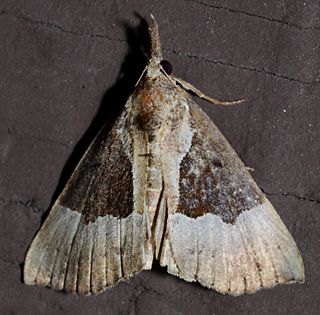
Hypena bijugalis, the dimorphic bomolocha, dimorphic hypena or toothed snout-moth, is a moth of the family Erebidae. The species was first described by Francis Walker in 1859. It is found in North America from Nova Scotia across southern Canada to Vancouver Island, south over the whole United States to Florida.

Caenurgina caerulea, the cerulean looper moth, is a moth of the family Erebidae. It is found in large parts of North America, including California, and British Columbia.
Schinia persimilis, the persimilis flower moth, is a moth of the family Noctuidae. The species was first described by Augustus Radcliffe Grote in 1873. It is found from in western North America from east central Alberta and the Cypress Hills in Saskatchewan north to the southern Yukon, west and south to Colorado, Utah, California and Oregon.
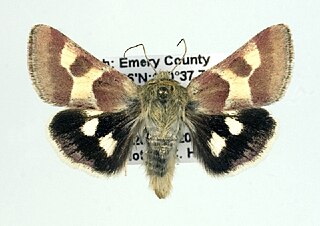
Schinia suetus is a moth of the family Noctuidae first described by Augustus Radcliffe Grote in 1873. It is widespread in the mountains of western North America, from southern Alberta west to British Columbia, south at least to Colorado and California, east to Idaho and New Mexico.
Photedes defecta, the narrow-winged borer, is a moth of the family Noctuidae. The species was first described by Augustus Radcliffe Grote in 1874. It is found in North America from Maryland and Massachusetts north to New Brunswick, west to North Dakota and British Columbia.

Colocasia propinquilinea, the closebanded yellowhorn, is a moth of the family Noctuidae. The species was first described by Augustus Radcliffe Grote in 1873. It is found in North America from Newfoundland and Labrador, west across the southern edge of the boreal forest to central Alberta, south to North Carolina, Missouri and Arkansas.
Spargaloma is a monotypic moth genus in the family Erebidae. Its only species is Spargaloma sexpunctata, the six-spotted gray. Both the genus and species were first described by Augustus Radcliffe Grote in 1873. It is found from coast to coast in lower Canada south in the east to Florida, Mississippi and Arkansas, in the west to California.
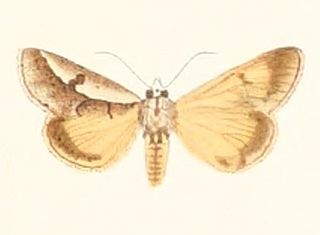
Euscirrhopterus poeyi, the pullback moth, is a moth of the family Noctuidae. The species was first described by Augustus Radcliffe Grote in 1866. It is found from southern Florida and Mexico, through Central America to Brazil. It is also found in the Caribbean, including Cuba.
Sitochroa aureolalis is a moth in the family Crambidae. It was described by George Duryea Hulst in 1886. It is found in the United States, where it has been recorded from southern California to Arizona and Texas. It is also found in northern Mexico.
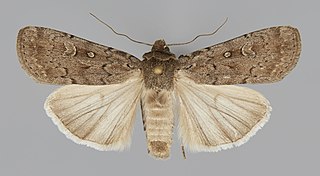
Actebia balanitis is a moth of the family Noctuidae first described by Augustus Radcliffe Grote in 1873. It is found from north-east Alaska and western Yukon east to east central Saskatchewan and north central South Dakota, south to northern Colorado and west to central Washington and the dry interior of British Columbia. The wingspan is 36–40 mm. Adults are on wing from June to August depending on the location. There is one generation per year.













